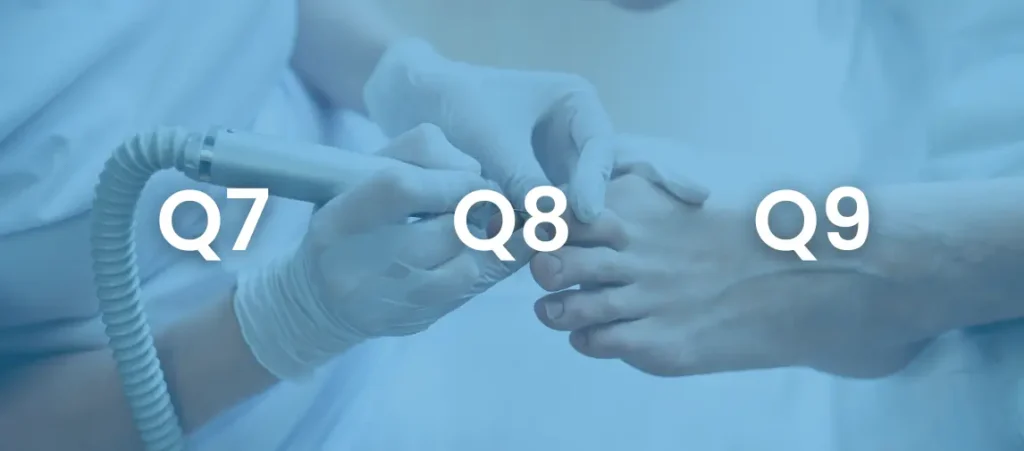In the twisty-turny world of podiatry billing, modifiers are the secret sauce that can make or break a claim. At Medical Billing Wholesalers, we’ve seen firsthand how these little two-character codes—like -Q7, -Q8, -Q9, and -59—can trip up even the savviest coders. Get them right, and your reimbursements glide through like a well-oiled ankle joint.
Get them wrong, and you’re staring down a denial faster than you can say “bunion.” Let’s dig into the nitty-gritty of podiatry modifiers, why they’re a big deal, and how to wield them like a pro.
Why Modifiers Matter in Podiatry
Podiatry billing is a quirky beast, blending routine care with surgical precision. Modifiers are the breadcrumbs that tell payers exactly what’s happening—whether it’s a diabetic foot check with class findings or a distinct procedure on a separate toe. According to a 2024 report from the American Academy of Professional Coders (AAPC), a whopping 25% of podiatry claim denials are tied to modifier errors.
That’s a quarter of your revenue limping out the door! As billing sage Rita Footnote puts it, “Modifiers are the spice of podiatry billing—too much or too little, and the dish is ruined!”
The Podiatry Modifier Lineup
Let’s meet the stars of the show—modifiers you’ll see more often than socks in a podiatrist’s office:

Q7, -Q8, -Q9: Class Findings for Routine Foot Care
These beauties are Medicare’s way of saying, “Prove it’s medically necessary.” Used with codes like CPT 11721 (nail debridement), they flag systemic conditions:
- Q7: Class A findings (e.g., non-traumatic amputation).
- Q8: Class B findings (e.g., absent pulses, advanced trophic changes).
- Q9: Class C findings (e.g., severe edema, claudication).
Per CMS, 40% of podiatry Medicare claims in 2023 used these modifiers—mess them up, and you’re toast.
- 59: Distinct Procedural Service
The granddaddy of modifiers, -59 tells payers, “Hey, this procedure is separate!” Think trimming a callus (CPT 11055) on one foot and a bunionectomy (CPT 28296) on the other. The Healthcare Billing and Management Association (HBMA) says -59 misuse accounts for 15% of podiatry denials—use it wisely. - Bonus Players: -TA to -T9
These toe-specific modifiers (e.g., -TA for left great toe, -T5 for right great toe) pinpoint which little piggy got the treatment. Essential for bilateral procedures, they’re a must-know for surgical claims.
Industry Data to Keep You on Your Toes
- Modifier Mishaps: The AAPC found 25% of podiatry denials in 2024 linked to modifier flubs—higher than the 18% average across specialties.
- Denial Costs: Reworking a denied claim costs $25-$30, per the Medical Group Management Association (MGMA). For a busy practice, that’s thousands down the drain.
- Routine Care Rejections: CMS data shows 30% of routine foot care claims without Q-modifiers get kicked back—ouch!
Scenarios for Modifier Success
- Scenario: Diabetic Foot Care
Case: Dr. Arch treats a diabetic patient with absent pulses (-Q8) and debrides six nails (CPT 11721).
Coding: 11721-Q8 + ICD-10 E11.9 (diabetes).
Why: -Q8 proves medical necessity, dodging a denial. “Skip the Q, and you’re billing air,” warns coder Mike Callus. - Scenario: Separate Procedures
Case: Dr. Sole fixes a bunion (CPT 28296) on the right foot and trims a callus (CPT 11055) on the left.
Coding: 28296-RT + 11055-59-LT.
Why: -59 flags the callus trim as distinct, ensuring both get paid. - Scenario: Bilateral Toes
Case: Dr. Heel injects cortisone into the left second toe (CPT 20600) and right great toe.
Coding: 20600-T1 + 20600-T5.
Why: Toe modifiers clarify the sites, avoiding bundling confusion.
Tips from Medical Billing Wholesalers
Here’s how to keep your modifiers sharp and your claims smooth:
- Know the Rules: Study Medicare’s Local Coverage Determinations (LCDs) for Q-modifier criteria. A 2023 HBMA study found trained coders cut errors by 40%.
- Software Solutions: Billing platforms with modifier alerts—like those we use at Medical Billing Wholesalers—slash mistakes by 50%, per RevCycle Intelligence, 2024.
- Audit Early, Audit Often: Pre-submission audits catch 80% of modifier goofs (MGMA). Make it a habit.
- Document Like a Boss: Detailed notes (e.g., “absent dorsalis pedis pulse”) back up your Q-modifiers, saving your bacon in audits.
Real-World Wackiness
Picture this: Dr. Toe-Tapper bills CPT 11721 for a nail trim but forgets the -Q8, despite the patient’s diabetes and trophic changes. Medicare denies it faster than a barefoot sprint on hot pavement. Resubmission eats $30 and a week’s time. “It’s like serving soup without a spoon—useless!” groans biller Jenny Bunion. Add the modifier, and it’s smooth sailing.
Conclusion
Modifiers in podiatry billing are like the perfect pair of orthotics—custom-fit and essential for support. At Medical Billing Wholesalers, we’ve got the expertise to season your claims just right, dodging denials and boosting revenue. Whether it’s Q-modifiers for routine care or -59 for surgical wins, we’re here to keep your practice stepping lively. Need help mastering the modifier maze? Contact us today—let’s spice up your billing without burning the books!


